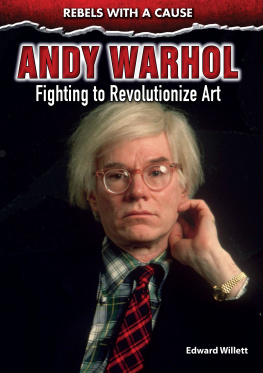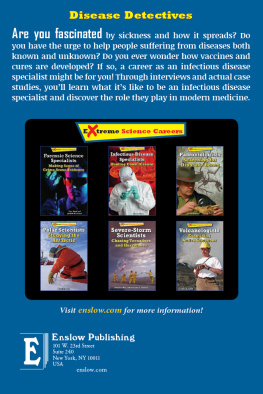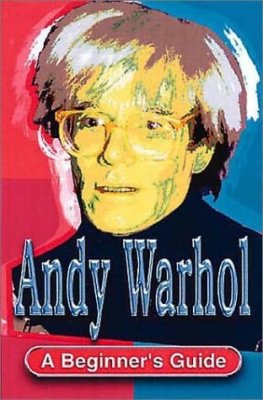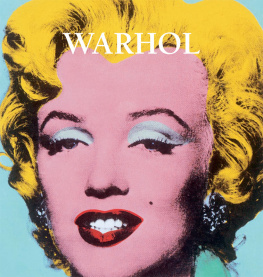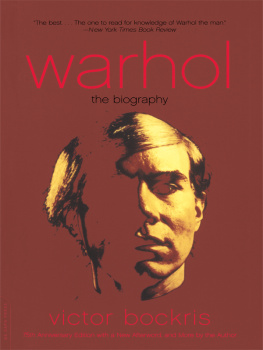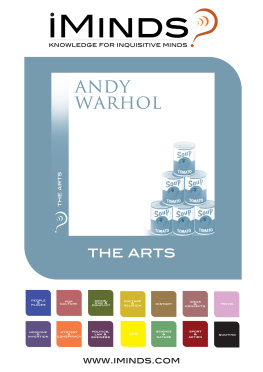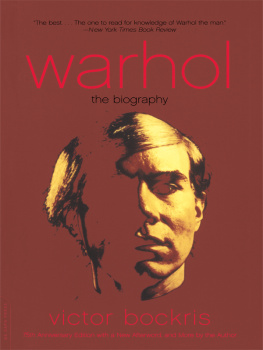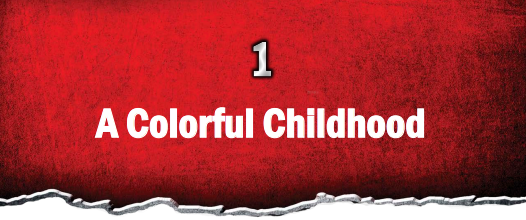Published in 2018 by Enslow Publishing, LLC.
101 W 23rd Street, Suite 240, New York, NY 10011
Copyright 2018 by Edward Willett All rights reserved.
No part of this book may be reproduced by any means without the written permission of the publisher.
Library of Congress Cataloging-in-Publication Data
Names: Willett, Edward, 1959- author.
Title: Andy Warhol : fighting to revolutionize art / by Edward Willett.
Description: New York : Enslow Publishing, 2018. | Series: Rebels with a cause | Includes bibliographical references and index. | Audience: Grades 7-12.
Identifiers: LCCN 2017031811 | ISBN 9780766092594 (library bound) |
ISBN 9780766095489 (paperback)
Subjects: LCSH: Warhol, Andy, 1928-1987Juvenile literature. | ArtistsUnited States BiographyJuvenile literature.
Classification: LCC N6537.W28 W575 2017 | DDC 700.92 [B] dc23 LC record available at https://lccn.loc.gov/201703181
Printed in the United States of America
To Our Readers: We have done our best to make sure all website addresses in this book were active and appropriate when we went to press. However, the author and the publisher have no control over and assume no liability for the material available on those websites or on any websites they may link to. Any comments or suggestions can be sent by email to .
Portions of this book originally appeared in the book Andy Warhol Everyone Will be Famous for 15 Minutes
Photo Credits: Cover, p. 1 Nancy R. Schiff/Archive Photos/Getty Images; p. 7 Nicolas Asfouri/ AFP/Getty Images; p. 10 Catherine McGann/Archive Photos/Getty Images; p. 13 Michael Ochs Archives/Getty Images; pp. 19, 82, 98 Bettmann/Getty Images; pp. 21, 38, 49, 68 Herve Gloaguen/Gamma-Rapho/Getty Images; p. 24 Apic/Hulton Archive/Getty Images; p. 26 Robert R. McElroy/Archive Photos/Getty Images; pp. 32, 34, 86 Jack Mitchell/Archive Photos/Getty Images; p. 40 Robert Alexander/Archive Photos/Getty Images; pp. 42, 110 Archie Carpenter/ Getty Images; pp. 44-45, 52 Mario De Biasi/Mondadori Portfolio/Getty Images; p. 55 Santi Visalli/Archive Photos/Getty Images; p. 59 Vernon Shibla/New York Post Archives/Getty Images; p. 61 John Springer Collection/Corbis Historical/Getty Images; p. 64 Everett Collection Inc./Alamy Stock Photo; p. 72 New York Daily News Archive/Getty Images; p. 79 Jack Smith/ New York Daily News Archive/Getty Images; p. 84 AP Images; p. 88 Ken Heyman/Woodfin Camp/The LIFE Images Collection/Getty Images; pp. 90-91, 96 Robin Platzer/The LIFE Images Collection/Getty Images; p. 103 Patrick McMullan/Getty Images; p. 105 Jeffrey M. Frank/Shutterstock.com; p. 109 RDA/Hulton Archive/Getty Images; p. 111 Vanessa Carvalho/ LatinContent/Getty Images; interior pages graphic element Eky Studio/Shutterstock.com.


N obody had ever seen anything quite like the art exhibition that opened July 9, 1962, in the Ferus Gallery in Los Angeles. Thirty-two paintings of Campbells Soup cans (one for each flavor) were displayed on a shelf as if they were real cans. Each measured twenty by twenty-six inches, and each was priced at $100.
Only six sold (one to actor Dennis Hopper). Another gallery not far away bought a bunch of real soup cans, put them in the windows, and offered three for just sixty cents.
But while the soup paintings didnt attract buyers, they attracted publicity. Two months before, on May 11, 1962, TIME magazine had said that a segment of the advance guard of painters had decided that the most banal and even vulgar trappings of modern civilization can, when transposed literally to canvas, become Art.
A thirty-year-old New York-based commercial artist named Andy Warhol, then engaged in painting soup cans, of all things, was quoted as saying, I just paint things I always thought were beautiful, things you use every day and never think about. I just do it because I like it.
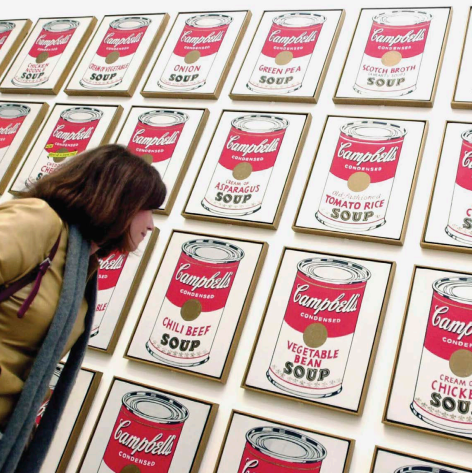
While considered strange and unique-and unsellable-when he first produced them, Warhols soup can images have since gone on to be some of the most famous and recognizable works of art.
TIME called the new style the Slice-of-Cake School but the name it finally ended up with was Pop Art. Before long, Warhol would become the Prince of Pop and its most famous creator. That fame outlasted the Pop Art movement. Warhol once famously said, In the future everybody will be world-famous for fifteen minutesWhile alive, he spent more than a quarter century as a world-renowned art star, and now, more than thirty years after his death, hes still as famous and controversial as ever.
Back in 1962, gallery owner Irving Blum bought all the Campbells Soup Can paintings back from the handful of purchasers and bought the rest of the set from Warhol for $1,000. In 1996, the Museum of Modern Art (MoMa) acquired them from Blum for an estimated $15 million.
Warhol, a true American rebel and a trendsetter rather than a trend follower, would have loved that.
A ndy Warhol was born Andrew Warhola in Pittsburgh, Pennsylvania, on August 6, 1928, the youngest son of Ondrej and Julia Warhola. His parents were both from the Ruthenian village of Mikova, Slovakia, located in the Carpathian Mountains near the borders of Russia and Poland.
After the end of the First World War, Ondrej started trying to bring Julia to the US, where he had moved years earlier. He sent her the fare five times in 1919, but none of the money reached her. In 1921, she borrowed $180 from a priest and finally made it to Pittsburgh. In 1922, the couples first son, Paul, was born; their second, John, was born in 1925.
By the time Andy was born in 1928, Ondrej was often away for work for weeks or months; he was employed by a company that built roads and moved houses to make way for new construction. Julia still couldnt speak English.
The Depression Hits Home
As the Great Depression took hold, Ondrej lost his job. Fortunately, he had several thousand dollars in savings, which allowed him to feed his family, but forced them to move into a two-room apartment where Paul, John, and Andy had to sleep in the same bed. In the overcrowded conditions, Paul and John often fought each other. Julia began working part-time, cleaning houses and making sculptures out of tin cans. Paul sold newspapers on streetcars.

Andy Warhols childhood home in Pittsburgh, Pennsylvania. Andy first discovered his love of art-and celebrity-while living in this house with his family.
When Andy was four years old, his father regained his job and was once again called away frequently, leaving Paul, age ten, as head of the household. Paul, who hadnt been able to speak English when he started school and had also developed a speech impediment, began to skip school and to take out some of his frustrations by disciplining his little brother. Paul later said that Andy was picking up bad language from kids in the street. The more you smacked him, the more he said it, the worse he got.

